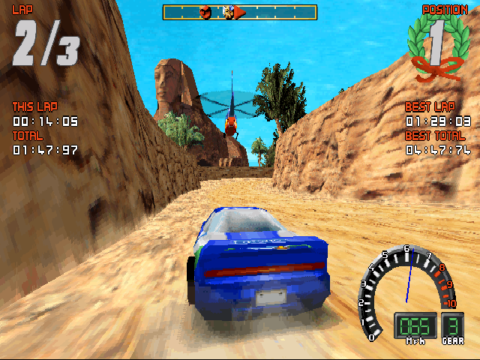
Screamer 2
Written by: Rik
Date posted: June 17, 2022
- Genre: Racing
- Developed by: Milestone (formerly Graffiti)
- Published by: Virgin Interactive Entertainment
- Year released: 1996
- Our score: 6
If the original Screamer was the PC’s answer to Ridge Racer, then Screamer 2 aims its sights at another arcade and console favourite, Sega Rally. Which, unlike Ridge Racer, was actually released on PC eventually, as part of a series of (then) power-hungry Windows 95 ports that followed the commercial demise of the Sega Saturn. I haven’t played it, readers, and nor am I likely to, but the sequel that was also released on the Dreamcast fell on the good side of ok, from what I remember.
On PC, Screamer 2 beat Sega Rally to the punch, and generally received a warm enough reception sufficient for the teenage Rik to shell out for a budget White Label copy, the jewel case of which still remains among my dusty old boxes. As with many games from my teenage years, I lost interest almost as soon as I realised that I wasn’t immediately good at it, and after that it was brought out for brief periods of split-screen multiplayer only.
Since I covered the first game and discovered it could be beaten with a small amount of persistence and concentration (which brought shame on my younger self), I’ve geared myself up for this sequel a few times, only to find my levels of performance to be roughly as I left them some 25 years ago, and eliciting a similarly childish response.
Despite being very clearly related to the previous game in terms of presentation and approach, the actual racing in Screamer 2 is rather different. This is a game in which mastery of the powerslide is fundamental. And I do mean mastery: without getting your racing line right, sliding at the right time, and at the right angle, you’re going to be bouncing off the scenery and ending up in last place. It all takes some getting used to, particularly as the opening track in England, advertised as ‘Easy’, remained in my experience among the more challenging of the six available, and will likely have you cursing your luck and wondering just how hard this game is. Which is probably why I kept picking it up and putting it down again.
The structure is fairly simple and typical of the era: Arcade is not an actual arcade mode, but a chance to play a single race; there’s the Championship, which is the meat of the game; and finally we have the often-included, but rarely-used, time trial. You choose a team (named, somewhat mysteriously: Angel, Condor, Zeus and Wasp) before selecting a car, of which only four are initially available, across all teams: Horizon (Toyota Supra), Nebula (Honda NSX), Spark (Mazda MX5) and Radiance (Porsche 911). The significance of the teams at this point essentially comes down to what colour car you like, although ultimate success in the championship unlocks a unique bonus vehicle for each team.
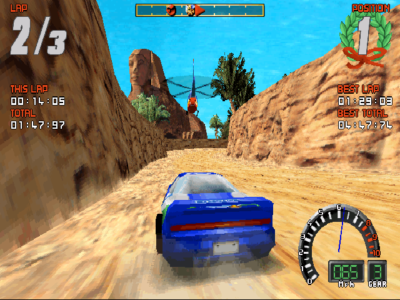
Fans of helicopters swooping over the track in racing games for no particular reason will find plenty to enjoy here.
Cars can be changed between each championship race, and whatever your choice, your three opponents will take one each of the others. The exception is the fourth and final championship league, in which you’ll be racing against the bonus cars. The beginner league (League 1) has four races, League 2 five, and Leagues 3-4 six, with the fourth adding the additional challenge of faster opponent vehicles. The other consideration is car setup, with tyres, handling, suspension and brakes all able to be tweaked for each race, according to the weather and track surface.
Such tinkering comes as a surprise in an arcade racer, and particularly when you realise that you can’t just ignore it all and stick with the default settings and expect to succeed. On top of that, vehicle selection is actually important too, but the only in-game information available is the drivetrain and top speed. On my own it was fairly easy to establish that the two 4WD vehicles are a bit easier to handle, with the fastest car, the RWD Porsche, being an absolute pig to drive.
Unfortunately Screamer 2 is one of those old games that has secured a digital re-release without anyone seeming able to lay their hands on the manual. Whether anything useful with regard to setups is covered in such a document, I don’t know, but in its absence I was forced to turn to GameFAQs for the thoughts of a teenager in the 90s.
Without such guidance, I would likely have floundered, and even with it, victory was far from assured. Championship seasons have to be completed in one go, so it’s a case of stringing your best performances on each track together to earn the most points and finish on top. The AI is fairly tenacious, without being unbeatable, and employs a level of moderate catch-up logic that at least keeps opponents within touching distance if you foul up early on, or if, as is more likely, they smash into you. Tracks are supposed to get harder, although I personally found the first two (England and Egypt) rather tricky, the third (California) pretty easy, the fourth (Finland) hard, the fifth (Switzerland) easy again, and the final one (Columbia) ludicrously difficult (as it arguably should be).
Such are the beats of an old school arcade racer – learn the tracks, master their tricky bits, don’t inexplicably mess up the easy ones, and then put it all together under pressure. It’s fun in a way that the modern racer, stuffed with numerous but largely interchangeable events, often isn’t. The stakes are high, there’s considerable tension, and your teeth clench while a claw forms over the arrow keys, muttered swear words never far away.
You have to get in the zone, ideally memorising which turns are coming up and beginning to slide before the on-screen prompt reminds you to, with lapses in concentration ruthlessly punished. Victories are hard earned, while defeats (particularly on super-hard tracks where you kind of give up after bouncing from corner to corner and trudge into last place) are chastening.
While I pieced together enough competent performances to reach the end, I didn’t quite get to the level of mastering all courses, with a second or third place the best I could hope for on some. As such, when that was achieved, which doesn’t take that long, I couldn’t imagine doing it all again. Which is potentially an option, in order to unlock all of the secret cars. I have to assume that the fourth league is the final one, as nothing extra seemed to be unlocked when I won it: neither did the secret tunnel track unlock, either, leaving me slightly unclear as to what else might be required. A comment on the GOG forums seems to indicate that even unlocking all four bonus cars doesn’t seem to do it, which would put me well beyond the amount of time I’d be prepared to put in anyway.
Overall, though, Screamer 2 still manages to deliver a short, sharp burst of solid arcade action. The visuals are a bit raggedy, and though the GOG release comes with additional 3dfx support not available at the time, the smoother textures delivered by that version are undermined by some mild texture glitching that arguably makes things look equally raggedy but in a slightly different way. Plus, the music fell into the ‘oh no, I really do have to turn this off now’ category, despite seeming on the surface to be a relatively uncontroversial 90s dance backing track – but at least there’s no hyper-enthusiastic voice-over man this time around. Otherwise, it stands up pretty well, and serves as a decent palate-cleanser if you’re feeling fatigued by the long-winded career modes of its more modern arcade racing counterparts.

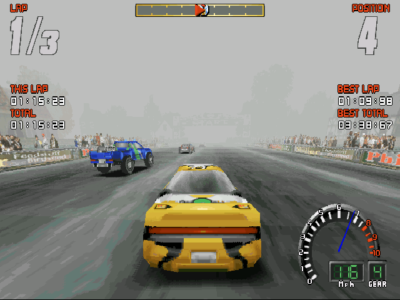
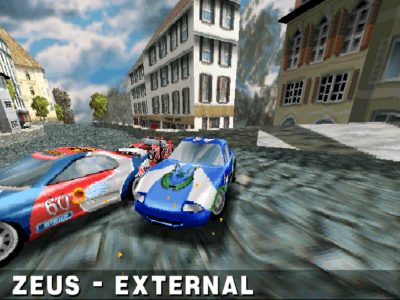
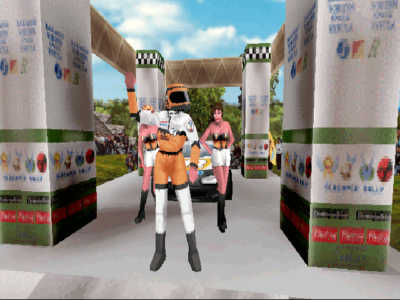

 Posts
Posts